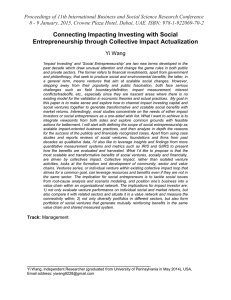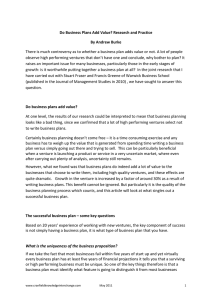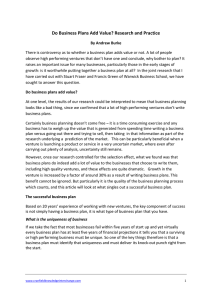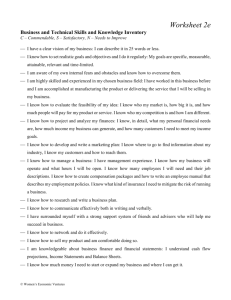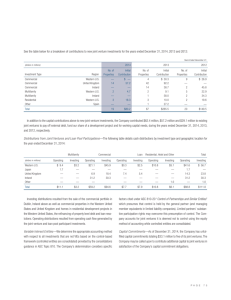Impact Investing & Social Ventures: Risk Capital for Expanding Innovation
advertisement
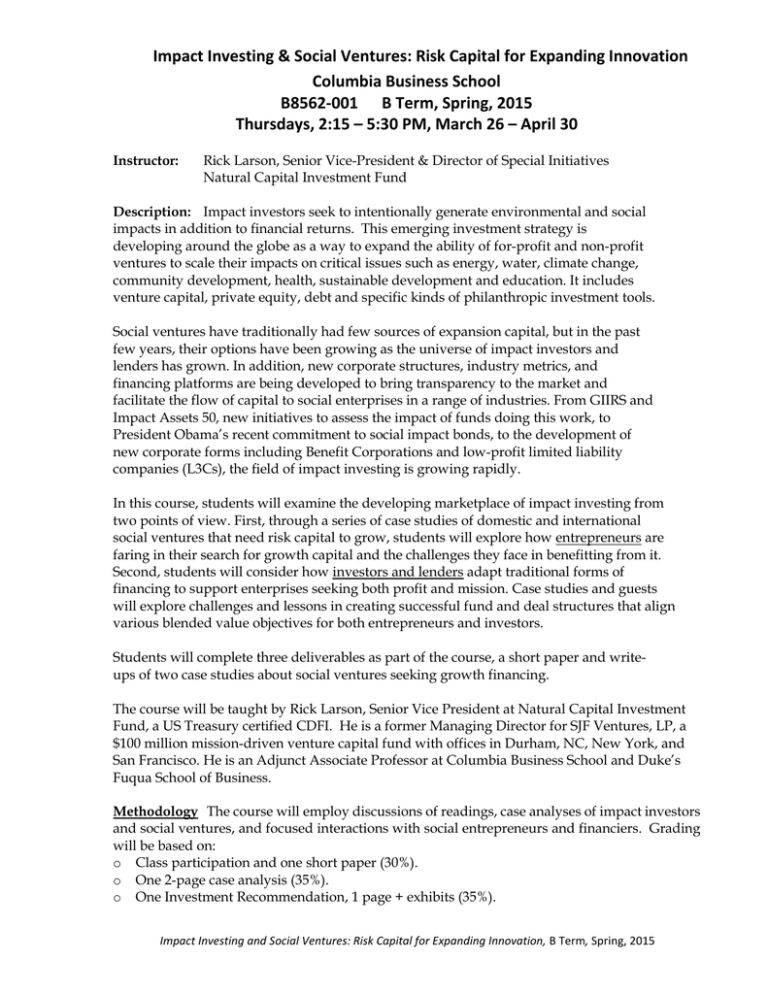
Impact Investing & Social Ventures: Risk Capital for Expanding Innovation Columbia Business School B8562-001 B Term, Spring, 2015 Thursdays, 2:15 – 5:30 PM, March 26 – April 30 Instructor: Rick Larson, Senior Vice-President & Director of Special Initiatives Natural Capital Investment Fund Description: Impact investors seek to intentionally generate environmental and social impacts in addition to financial returns. This emerging investment strategy is developing around the globe as a way to expand the ability of for-profit and non-profit ventures to scale their impacts on critical issues such as energy, water, climate change, community development, health, sustainable development and education. It includes venture capital, private equity, debt and specific kinds of philanthropic investment tools. Social ventures have traditionally had few sources of expansion capital, but in the past few years, their options have been growing as the universe of impact investors and lenders has grown. In addition, new corporate structures, industry metrics, and financing platforms are being developed to bring transparency to the market and facilitate the flow of capital to social enterprises in a range of industries. From GIIRS and Impact Assets 50, new initiatives to assess the impact of funds doing this work, to President Obama’s recent commitment to social impact bonds, to the development of new corporate forms including Benefit Corporations and low-profit limited liability companies (L3Cs), the field of impact investing is growing rapidly. In this course, students will examine the developing marketplace of impact investing from two points of view. First, through a series of case studies of domestic and international social ventures that need risk capital to grow, students will explore how entrepreneurs are faring in their search for growth capital and the challenges they face in benefitting from it. Second, students will consider how investors and lenders adapt traditional forms of financing to support enterprises seeking both profit and mission. Case studies and guests will explore challenges and lessons in creating successful fund and deal structures that align various blended value objectives for both entrepreneurs and investors. Students will complete three deliverables as part of the course, a short paper and writeups of two case studies about social ventures seeking growth financing. The course will be taught by Rick Larson, Senior Vice President at Natural Capital Investment Fund, a US Treasury certified CDFI. He is a former Managing Director for SJF Ventures, LP, a $100 million mission-driven venture capital fund with offices in Durham, NC, New York, and San Francisco. He is an Adjunct Associate Professor at Columbia Business School and Duke’s Fuqua School of Business. Methodology The course will employ discussions of readings, case analyses of impact investors and social ventures, and focused interactions with social entrepreneurs and financiers. Grading will be based on: o Class participation and one short paper (30%). o One 2-page case analysis (35%). o One Investment Recommendation, 1 page + exhibits (35%). Impact Investing and Social Ventures: Risk Capital for Expanding Innovation, B Term, Spring, 2015 Impact Investing & Social Ventures: Risk Capital for Expanding Innovation Columbia Business School B Term, Spring, 2015 B5862-001 Syllabus 3/26 SESSION ONE Tensions in Impact Investing Topics: What’s unique about social and environmental innovators and their ventures? Why do they need impact investment to go to scale? What is Impact Investing? o Social venture unique characteristics. o Overview of impact investing space. Reading: The Impact Investor: Lessons in Leadership and Strategy for Collaborative Capitalism, Clark, Emerson and Thornley (Jossey Bass 2015), pp. 1-12, 19-44, 58-107. Spotlight on the Market: Morgan/GIIN) 4/2 The Impact Investor Survey (2014) (JP Case: Root Capital: Investment in the Developing World (Columbia Caseworks, 2009) SESSION TWO How Social Venture Capital Works: Portfolio Management and Structuring an Investment Topics: How are venture capital funds structured? How do “social” venture funds differ? How are social and financial value measured by social venture investors? How does the integration of social and environmental objectives change the terms and conditions of an investment? How do investors structure their investments to earn a return? o Venture capital fund mechanics. o Market creation o Valuation and deal structuring. Readings: “The Pioneer Gap,” From Blueprint to Scale (Monitor, April 2013), pp. 10-19. “Executive Summary, Impact Investing 2.0: The Way Forward – Insight from 12 Outstanding Funds,” (PCV, Impact Assets, Duke University Fuqua School of Business, November 2013). “How Venture Capital Works,” Zider (HBR). Introduction to Termsheets, ANDE Case: Acumen Fund and Embrace: From the Leading Edge of Social Venture Investing (Stanford Graduate School of Business, April 2011). Syllabus -Impact Investing and Social Ventures: Risk Capital for Expanding Innovation, B Term, Spring, 2015, p 1 4/9 SESSION THREE How Social VC Works: Measurement and Results Topics: How do individual companies and funds set their social and environmental standards? Are impact and “market rate” financial return mutually exclusive? What risks do liquidity events pose for mission-driven companies? Can standards and metrics help expand the field of impact investment? o Overview of social venture capital funds. o Metrics. Readings: “A New World of Metrics: Trends in Monitoring Social Return,” Clark and Emerson, in “Investing For Impact,” Credit Suisse Research Institute, 2012, pp. 31-35. SJF Ventures: Positive Impact Report, 2013. GIIRS 2011 Progress Report 4/16 Case (WRITE UP): SJF Ventures & Ryla Teleservices (Leamon, Community Development Venture Capital Alliance, 2004). SESSION FOUR Innovations in Non-Profit Social Venture Financing Topics: How and where do non-profit social ventures attract risk capital? What challenges does a non-profit structure create for expansion capital? o Structuring debt as equity. o Foundations: PRIs & MRIs. o Non-profit lending entities and structures. Readings: Miller, “Hidden in Plain Sight: Understanding Nonprofit Capital Structure” (The Nonprofit Quarterly, Spring, 2003). Miller, “The Equity Capital Gap,” (Stanford Social Innovation Review, June 1, 2008). “The World Has Changed and So Must We,” Clara Miller, President, The F.B. Heron Foundation, 2013. Case: 4/23 SESSION FIVE Partners for the Common Good/FirstBook Marketplace (Columbia CaseWorks, 2008). Innovations for Governments and Individuals Topics: How are governments, investment structures, and angel investing changing to respond to the desire for impact in investments? Case: Social Finance, Inc. (HBS, 2012) Case Study: Deutsche Bank Global Commercial Microfinance Consortium I, Impact Investing 2.0, November 2013 Syllabus: Impact Investing & Social Ventures: Risk Capital for Expanding Innovation, B Term, Spring, 2014, p2 Readings: “Foundations for Social Impact Bonds: How and Why Philanthropy Is Catalyzing the Development of a New Market,” Social Finance, 2014. Impact Assets 50 2011 (Impact Assets). Guest Speaker: 4/30 SESSION SIX Casey Littlefield, Director, Social Finance US Going to Scale: Matching Form and Function Topics: How does the Impact Investing industry need to evolve to help take innovation to scale? How can non-profit social ventures utilize innovative structures to attract equity capital? What structures and mechanisms are being developed to protect a company’s social/environmental mission in the face of leadership or ownership changes? o Determining the right financing and legal structure to facilitate growth. o For profit spin-offs. CASE (WRITEUP): TransFair USA in 2006: How to Finance Growth? (Columbia CaseWorks, 2012). Syllabus: Impact Investing & Social Ventures: Risk Capital for Expanding Innovation, B Term, Spring, 2014, p3
